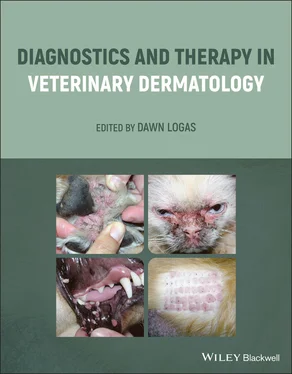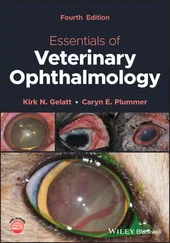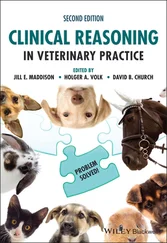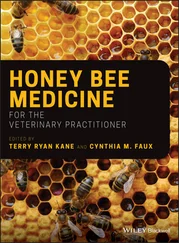LC record available at https://lccn.loc.gov/2021043862LC ebook record available at https://lccn.loc.gov/2021043863
Cover Design: Wiley
Cover Image: © Dawn Logas
First, I want to thank Gail Kunkle and Richard Halliwell for their support and mentorship that got me started in dermatology. Second, I want to thank my clients and patients over the last 35 years who have taught me so much about dermatology that I did not know before. Next, I want to thank my husband, Paul, and sons, Christopher and Jacob, for all their love and support over the years. I love you guys more than you will ever know. Finally, I want to thank my best friend and business partner, Marcia Schwassmann, for making me a better person and veterinarian along with helping me edit this book.
Dawn Logas
Dear Colleague
This book is not meant to be an all‐inclusive dermatology text. It is meant to help you understand how dermatologists think and what we feel is important when working up our cases, so you can improve how you work up your own dermatology cases. It will also hopefully improve the use of our veterinary nurses and the communication between the primary care veterinarian and the dermatologist. Furthermore, I have included information in this book about diseases whose incidences are increasing because of climate change and issues such as antibiotic resistance, which are not found in other currently available dermatology texts. As veterinarians we will become more important in the One Health movement as infectious diseases spread to new areas and antibiotic resistance continues to spread.
I want to thank the authors who contributed to this book for their hard work and diligence in delivering practical chapters with information that primary care veterinarians can use every day.
Dawn Logas
Joseph M. Blondeau, BSc, MSc, PhDRoyal University Hospital and University of Saskatchewan, Saskatoon, Saskatchewan, Canada
Leah D. Blondeau, PhDRoyal University Hospital and University of Saskatchewan, Saskatoon, Saskatchewan, Canada
Megan Boyd, DVM, DACVDAnimal Dermatology Center, Studio City, CA, USA
Ceara Byrne, MS CS Georgia Tech, PhDGeorgia Institute of Technology School of Interactive Computing, Atlanta, GA, USA
Christine L. Cain, DVM, DACVDSchool of Veterinary Medicine, University of Pennsylvania, Philadelphia, PA, USA
Ana Milena Carmona‐Gil, DVM, MScDermaVet Centro de Dermatología Veterinaria, Medellín, Antioquia, Colombia
Catlin Contreary, DVM, DACVDVeterinary Dermatology Center, Maitland, FL, USA
Katherine Doerr, DVM, DACVDVeterinary Dermatology Center, Maitland, FL, USA
Valerie Fadok, DVM, DACVD, PhDZoetis, Bellaire, TX, USA
Cecilia Friberg, DVM, DACVDSodra Djursjukhuset, Stockholm, Sweden
Natalie Gedon, DVMUniversity of North Carolina College of Veterinary Medicine, Raleigh, NC, USA
Darcie Kunder, VMD, DACVDFriendship Hospital for Animals, Washington, DC, USA
Judy Lethbridge, RVT (registered veterinary technician)Veterinary Dermatology Center, Maitland, FL, USA
Dawn Logas, DVM, DACVDVeterinary Dermatology Center, Maitland, FL, USA
Jacob Logas, MS CS Georgia Tech, PhDGeorgia Institute of Technology School of Interactive Computing, Atlanta, GA, USA
Rosanna Marsella, DVM, DACVDUniversity of Florida, Gainesville, FL, USA
Ralf Mueller, DVM, MANZCVSc (Canine Medicine), DACVD, FANZCVSc (Dermatology), DECVDCentre for Clinical Veterinary Medicine, LMU Munich, Germany
Luisito S. Pablo, DVM, MS, DACVAACollege of Veterinary Medicine, University of Florida, Gainesville, FL, USA
Mark G. Papich, DVMNorth Carolina State University, Raleigh, NC, USA
Jason B. Pieper, DVM, MS, DACVDIowa State University, Ames, IA, USA
Domenico Santoro, DVM, MS, DrSc, PhD, DACVD, DECVD, DACVM (Bacteriology, Mycology, Immunology)University of Florida, Gainesville, FL, USA
JoAnn Stewart, RVT, CVPM, CCFPExecutive Director, Collaborative Care Coalition, Gurnee, IL, USA
Rebekah Westermeyer, BSEd, DVM, DACVD, MRCVSAnimal Allergy Specialists, Oahu, HI, USA Asia Veterinary Diagnostics, Kowloon, Hong Kong
Amelia White, DVM, MS, DACVDAuburn University College of Veterinary Medicine, Auburn, AL, USA
Michelle Woodward O’Gorman, DVM, DACVDBaton Rouge Veterinary Specialists, Baton Rouge, LA, USA
1
The Skin as an Immune Organ
Domenico Santoro and Megan Boyd
The skin is an extremely active immunologic organ.
The skin has many resident immunologically active cells.
The skin defense system includes a physical barrier (stratum corneum and hair), a chemical barrier (fatty acids and antimicrobial peptides), an immunologic barrier (innate and adaptive immune system), and a microbiological barrier (beneficial microorganisms).
Keratinocytes are the most immunologically active cells in the epidermis.
The skin is commonly affected by immune system disorders.
The skin is the largest organ in the body. It has long been known as the primary physical barrier between an organism and its environment, but since the early 1980s the skin has been recognized as an active immune organ with its own skin‐associated immune system. The skin’s defense system consists of physical, chemical, immunologic, and microbiologic components that protect the body against trauma, chemicals, toxins, and microorganisms.
The physical barrier represents the first line of defense against invaders. It is composed of keratinocytes tightly bonded together by a lipid‐rich mortar in the stratum corneum (top layers) and keratinocytes joined together by tight cell‐to‐cell junctions in the lower layers. The chemical barrier consists of compounds with active antimicrobial activity, including fatty acids and antimicrobial or host defense peptides secreted by sebaceous glands and keratinocytes. If the physical and chemical defenses of the skin are overcome by invaders, components of the innate and active immune system along with beneficial microorganisms in the skin microbiome become important. Beneficial microorganisms compete for the same niche as pathogens and actively secrete antimicrobial peptides (AMPs) that inhibit the proliferation of pathogenic competitors.
When pathogenic microorganisms breach the physical and chemical defenses of the skin, they activate the skin‐associated lymphoid tissue (SALT) ( Table 1.1). SALT includes dendritic cells, mast cells, lymphocytes, and keratinocytes, and forms part of the innate immune system ( Figure 1.1). Innate immunity, which is considered the most ancient branch of the body’s immune defenses, is characterized by a rapid onset of action (minutes to hours), a lack of specificity (it recognizes common microbial structures as opposed to specific organisms), and a lack of memory, which means the response does not improve with each exposure. Cells of the innate immune system include macrophages, dendritic cells, neutrophils, natural killer (NK) cells, mast cells, and keratinocytes. When innate immunity is overwhelmed, the adaptive branch of the immune system ( Figure 1.2), primarily made of T and B lymphocytes, is activated. The adaptive immune response is characterized by a slow onset of action (days to weeks), high specificity (recognizes unique antigens), and memory, which means the speed and magnitude of the response improve with each exposure. The innate and adaptive branches of the immune system are highly interconnected. When cells of the innate immune system are activated, they secrete numerous inflammatory cytokines and chemokines that prime and direct the adaptive immune system’s response.
Читать дальше












